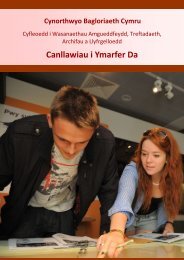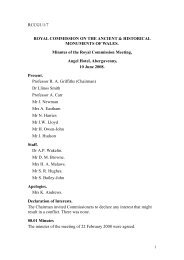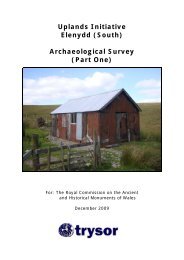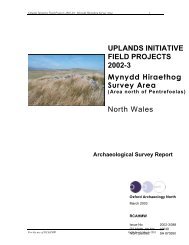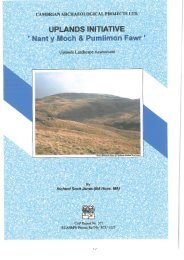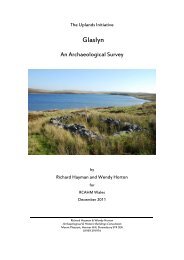Foel Goch Archaeological Survey - Royal Commission on the ...
Foel Goch Archaeological Survey - Royal Commission on the ...
Foel Goch Archaeological Survey - Royal Commission on the ...
Create successful ePaper yourself
Turn your PDF publications into a flip-book with our unique Google optimized e-Paper software.
Uplands Initiative Field Projects 2011-12: <str<strong>on</strong>g>Foel</str<strong>on</strong>g> <str<strong>on</strong>g>Goch</str<strong>on</strong>g> <str<strong>on</strong>g>Survey</str<strong>on</strong>g> Report 24<br />
7. RECOMMENDATIONS<br />
7.1 RECOMMENDATIONS FOR FURTHER WORK<br />
7.1.1 It is recommended that investigati<strong>on</strong> in <strong>the</strong> form of palynological sampling and peat<br />
coring be undertaken within <strong>the</strong> study area. Sampling should take place in <strong>the</strong> boggy<br />
areas <strong>on</strong> <strong>the</strong> south-western limits of <strong>the</strong> study area adjacent to Llyn Maen Bras<br />
where <strong>the</strong>re is potential for deep peat deposits. Sampling should also take place both<br />
in <strong>the</strong> steep cwms surrounding <strong>the</strong> locati<strong>on</strong>s of ritual/funerary m<strong>on</strong>uments, adjacent<br />
to Llyn Caer Euni where <strong>the</strong>re is a profusi<strong>on</strong> of prehistoric activity, and around <strong>the</strong><br />
putative domestic sites <strong>on</strong> <strong>the</strong> west flank of Moel Emoel. This would not provide an<br />
absolute chr<strong>on</strong>ology for <strong>the</strong> sites, but palynological work from peat adjacent to <strong>the</strong><br />
sites would be able to determine clearance episodes and periods of potential<br />
agricultural activity in <strong>the</strong> vicinity of <strong>the</strong> sites.<br />
7.1.2 Detailed topographic survey should be undertaken <strong>on</strong> all of <strong>the</strong> identified prehistoric<br />
ritual/funerary cairns identified within <strong>the</strong> study area. Detailed topographic survey<br />
could elucidate details of <strong>the</strong>ir c<strong>on</strong>structi<strong>on</strong>, <strong>the</strong>ir surviving fabric and any later<br />
disturbance to <strong>the</strong> m<strong>on</strong>uments,. It could also shed light <strong>on</strong> <strong>the</strong>ir topographic setting<br />
and <strong>the</strong> inter-relati<strong>on</strong>ship between each of <strong>the</strong> m<strong>on</strong>uments and <strong>the</strong> wider landscape.<br />
7.1.3 There is little scope for fur<strong>the</strong>r recording at any of <strong>the</strong> few localised quarrying sites<br />
within <strong>the</strong> study area. The quarries recorded in <strong>the</strong> project are all associated with<br />
small-scale post-medieval extracti<strong>on</strong> for wall c<strong>on</strong>structi<strong>on</strong>.<br />
For <strong>the</strong> use of RCAHMW © OA North: February 2012




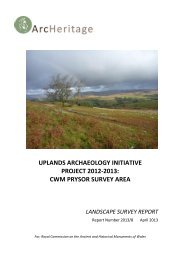
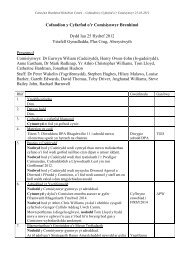
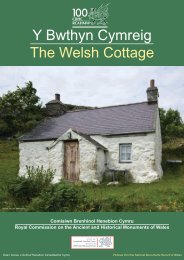

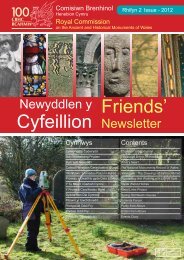
![The Source of the Usk Walk [2012 PDF]](https://img.yumpu.com/49285699/1/190x245/the-source-of-the-usk-walk-2012-pdf.jpg?quality=85)

